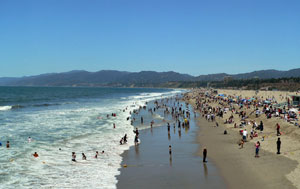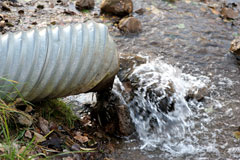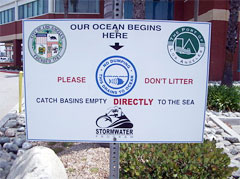Contact EPA Southern California
Pacific Southwest, Region 9
Serving: Arizona, California, Hawaii, Nevada, Pacific Islands, Tribal Nations
Water Quality
| Southern California Quick Finder | ||||
|---|---|---|---|---|
| Asbestos Brownfields Children's Health | Disaster Preparedness Grants Indoor Air | Leaking Fuel Tanks Mold | Ports RCRA ID Numbers Vehicle Imports | TMDLs Air Water Infrastructure Wildfires |

EPA's new sustainable water infrastructure site helps local utilities to save energy and reduce gases. More info »»
Protecting water quality for the citizens of southern California is a high priority for EPA. Our office enforces federal clean water and safe drinking water laws, provides support for municipal water infrastructure improvements, and takes part in pollution prevention efforts aimed at protecting watersheds and sources of drinking water.
On this page:- Municipal Stormwater Discharge Permits
- Development of Total Maximum Daily Loads (TMDLs)
- Grants to Improve Local Water Systems
- Wetlands and Section 404 Permits
Municipal Stormwater Discharge Permits

Controlling municipal storm water pollution is important because anything dumped or dropped on the ground or in the gutter can end up in the nearest body of water. Unlike wastewater that goes down a sink or toilet in your home, stormwater is not treated, and often flows directly to a lake, river, or the ocean. Stormwater systems are intended to route rainwater quickly off the streets. Unfortunately, these systems can also carry pollutants such as pesticides, bacteria and chemicals through city streets and straight to our waters. In southern California, municipal storm water is a significant contributor to water quality problems in streams and at beaches.

EPA’s National Pollutant Discharge Elimination System (NPDES) program permits for discharges from municipal storm sewers. California has been authorized by EPA to implement the NPDES stormwater permit program in all areas of the state except tribal lands. In southern California, the Regional Water Quality Control Boards issue Municipal Separate Storm Sewer System (MS4) permits to cover municipalities in urban areas. Each of these permits requires the municipalities to establish stormwater control programs to control pollution from industrial and commercial facilities, construction sites, new development, municipal activities, and to provide public education on stormwater pollution prevention. The regional boards have issued eight MS4 permits.
Local Municipal Stormwater Programs:
- Los Angeles Region:
 Ventura County, Los Angeles County
Ventura County, Los Angeles County - Colorado River Region:
 Riverside County
Riverside County - Santa Ana Region:
 Orange County, Riverside County, San Bernadino County
Orange County, Riverside County, San Bernadino County - San Diego Region:
 Orange County, San Diego County
Orange County, San Diego County
How You Can Help
Municipalities with responsibilities under these permits play an important role in protecting community health and local water quality. These municipalities rely on assistance from other partners, such as industry, developers, and residents to ensure that they can meet the requirements in their MS4 permits. Members of the public play a very important role in preventing pollution of neighborhoods, streams, and beaches. For example, the following are actions the public can take to help control storm water pollution:
- Take used motor oil and other automotive fluids to a recycling facility, don't dump these wastes on the ground or in the street.
- Don't litter. Cigarette butts and other trash are washed into storm sewers, and end up in our steams and beaches.
- Don't sweep or blow yard waste into streets and gutters.
- Don't use excess pesticides and fertizer. These chemicals should not be used near gutters and streets.
- Don't over-water lawns. In addition to wasting scarce water supplies, runoff carries contaminants and washes waste into storm sewer systems.
- Don't wash cars in driveways or in the street. Detergents, oils and grease are washed into the storm sewer and carried into our waters. Commercial car washes are required to remove these pollutants.
- Clean up dog waste.
EPA's Role
As part of our role in overseeing the NPDES program, EPA has conducted nearly fifty audits across Region 9 (Arizona, California, Hawaii, Nevada). Twenty of these audits have been conducted in Southern California. The purpose of these audits is to determine the effectiveness of the MS4 permits and assess how well the permit is being complied with. As a result of these audits EPA has provided suggestions for improvement of future permits. EPA has also taken enforcement actions against parties found to be in violation of permit requirements.
Additionally, one of EPA's major priorities for improved control of municipal storm water pollution is for the use of "green infrastructure" to manage storm water. This approach involves systems and practices that use or mimic natural processes to infiltrate, evapotranspirate (return water to the atmosphere via evaporation or via plants), and reuse storm water on the site it is generated, so that most runoff doesn't reach the storm sewer. On April 19, 2007, EPA and four national groups signed an agreement to promote green infrastructure as an environmentally preferable approach to storm water management. EPA is encouraging the incorporation of green infrastructure tools into renewed MS4 permits in southern California and across Region 9.
Additional Resources:
- NPDES Municipalities and Wastewater Treatment Plants
- California State Water Resources Control Board Storm Water Program

- Contact: John Kemmerer (kemmerer.john@epa.gov)
Development of Total Maximum Daily Loads (TMDLs)
Protecting the quality of local waterways requires the development of long term pollution control plans. Comprehensive water quality studies are performed which identify water quality trends, prioritize polluted waters, and target impaired waters which exceed pollution standards. Once a finding is made that a waterbody is not meeting water quality standards for a pollutant, a TMDL is developed.
A TMDL sets limits on how much pollution can be discharged into a body of water without violating water quality standards, and it allocates the total pollutant load among all the polluting sources in the watershed. Finally, entities responsible for the pollution are identified and a plan to clean up the pollution is developed. Usually, the state will complete TMDLs and work with the public and key stakeholders to determine the best implementation practices to address the pollution in the water. Draft TMDLs are made available for public review and comment prior to finalization.
EPA supports public participation before a TMDL document is completed and will participate in stakeholder advisory groups to address critical issues (for example, the Calleguas Creek Watershed TMDLs in southeast Ventura County ![]() ). EPA maintains a critical role in providing scientific and regulatory comments to other local, state and federal agencies on proposed TMDLs. EPA is the final stop to ensure watersheds are protected and water quality standards are achieved and maintained.
). EPA maintains a critical role in providing scientific and regulatory comments to other local, state and federal agencies on proposed TMDLs. EPA is the final stop to ensure watersheds are protected and water quality standards are achieved and maintained.
New TMDLs are currently under development in southern California for the counties of Ventura, Los Angeles and San Diego. Most TMDLs in California are issued by the State of California Water Resources Control Boards, ![]() and others are issued by EPA or by tribal authorities.
and others are issued by EPA or by tribal authorities.
Additional Resources:
- Keeping Trash Out of Waterways: LA Water Board Leads the Way
- EPA Monitoring, Assessment and TMDLs
- List of Impaired Waterbodies in California

- Monitoring, Assessment and TMDLs
- State Regional Water Boards links
- Los Angeles Regional Water Quality Control Board

- Santa Ana Regional Water Quality Control Board

- San Diego Regional Water Quality Control Board

- Colorado River Basin Regional Board

- Contact: Cindy Lin (lin.cindy@epa.gov)
Wetlands and Section 404 Program
The federal Clean Water Act requires that a permit be issued for activities which discharge dredged or fill materials into the waters of the United States, including wetlands. These permits, otherwise known as Section 404 permits, are issued by the U.S. Army Corps of Engineers (ACOE). ![]() EPA reviews and provides comments on each permit application to make sure it adequately protects water quality and complies with applicable guidelines. EPA also can take enforcement actions for violations of Section 404.
EPA reviews and provides comments on each permit application to make sure it adequately protects water quality and complies with applicable guidelines. EPA also can take enforcement actions for violations of Section 404.
EPA’s role in this process is targeted towards preserving natural habitat and healthy watersheds. We also encourage and consider public review and comments on permit applications. Some of the major permits for which we have recently provided comments include…(need info on SoCal projects here, including how EPA added value).
Additional Resources:
- Region 9 Wetlands Program
- Los Angeles ACOE Office

- Wetlands Authority Fact Sheet
- Contact: Jorine Campopiano (campopiano.jorine@epa.gov)
Improving Local Water Systems
EPA provides federal funding to municipalities for upgrades to drinking water and wastewater systems in Southern California. Communities use these funds to replace outdated sewer pipes and drinking water supply lines, as well as to upgrade water treatment plants, wells and reservoirs. The map at left shows the locations of some of these grants.
For example, Cathedral City received a grant from EPA for $477,900 in 2006 and is using the money to build a new sewer system which will eliminate the need for approximately 40 septic tanks. This project is part of a city-wide sewer system upgrade which will improve water quality in local neighborhoods and in the Coachella Valley. This project will consist of approximately 4000 feet of new sewer line.
The Orange County Sanitation District (OCSD) received $1,734,000 in EPA grants in 2004 and 2005, which is being used for wastewater treatment improvements and to build a new treatment facility in Fountain Valley. The new sludge dewatering and odor control facility will upgrade the facility in Fountain Valley to secondary treatment requirements under the Clean Water Act.
The County of Kern received $1,433,600 in 2006 for the Rexland Acres wastewater treatment project. The County is using the funding for the construction of a new sewer system which would eliminate septic systems by providing new sewer service to 746 homes. The County installed 29,450 lineal feet of sewer main and 25,090 lineal feet of force main.
Additional Resources:
- Water System Improvement Grants
- EPA Region 9 Water Program
- Contact: Howard Kahan (kahan.howard@epa.gov)

